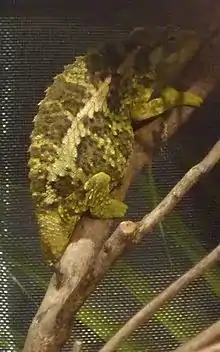| Trioceros werneri | |
|---|---|
 | |
| Female | |
| Scientific classification | |
| Domain: | Eukaryota |
| Kingdom: | Animalia |
| Phylum: | Chordata |
| Class: | Reptilia |
| Order: | Squamata |
| Suborder: | Iguania |
| Family: | Chamaeleonidae |
| Genus: | Trioceros |
| Species: | T. werneri |
| Binomial name | |
| Trioceros werneri (Tornier, 1899) | |
Trioceros werneri, the Wemer's chameleon or Wemer's three-horned chameleon, is a species of chameleon that is endemic to forests and nearby gardens at altitudes of 1,700–2,600 m (5,600–8,500 ft) in the Eastern Arc Mountains of Tanzania.[1][2] The adult male has three distinct "horns", whereas the female has no or only a single short horn on the nose.[3][4] Like many (but not all) Trioceros species of highlands, the female T. werneri does not lay eggs, but instead gives birth to live young, typically 15–20 at a time.[5]
Taxonomy
The three long annulated horns in the male T. werneri makes it superficially similar to T. jacksonii and T. johnstoni, and to extent also to the short-horned T. fuelleborni and the smooth-horned T. oweni,[3] but they are not close relatives.[5]
Although currently recognized as a single relatively widespread species, it is considered likely that T. werneri is a species complex and a taxonomic review is necessary.[1][4]
References
- 1 2 3 Tolley, K.; Menegon, M. (2014). "Trioceros werneri". IUCN Red List of Threatened Species. 2014: e.T172547A1345013. doi:10.2305/IUCN.UK.2014-3.RLTS.T172547A1345013.en. Retrieved 19 November 2021.
- ↑ "Trioceros werneri". The Reptile Database. Retrieved 2017-09-02.
- 1 2 Spawls, S.; Howell, K.; Drewes, R.; Ashe, J. (2002). A Field Guide to the Reptiles of East Africa. Academic Press. pp. 240–241. ISBN 0-12-656470-1.
- 1 2 "Trioceros werneri". chameleonacademy.com. Retrieved 31 October 2023.
- 1 2 Hughes, D.F.; Blackburn, D.G. (2020). "Evolutionary origins of viviparity in Chamaeleonidae". Journal of Zoological Systematics and Evolutionary Research. 58 (1): 284–302. doi:10.1111/jzs.12328.
